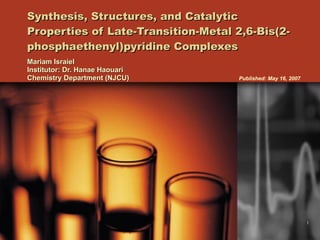Inorganic Chem Pre 2r
- 1. Synthesis, Structures, and Catalytic Properties of Late-Transition-Metal 2,6-Bis(2-phosphaethenyl)pyridine Complexes Mariam Israiel Institutor: Dr. Hanae Haouari Chemistry Department (NJCU) Published: May 16, 2007
- 2. Outline Synthesis of Rhodium(I) Complexes. [slide 5,6] Synthesis of Copper(I) Complex. [slide 7] Synthesis of Silver(I) Complex. [slide 8,9] Catalytic Hydroamidation of Enones. [slide 11]
- 3. Purpose Their recent effort has been focused on the development of transition-metal complexes coordinated with phosphaalkenes as low-coordinated phosphorus compounds. This property is useful for catalysis, leading to a highly efficient organic transformations.
- 4. Introduction In this study they have turned their research interest to the synthesis of 2,6-bis(2- phosphaethenyl) pyridine as a tridentate ligand ( PNP ) with 9 and 11 group metals. PNP complexes consists of a Ï -donative pyridine core and two Ï -accepting phosphaethenyl arms.
- 5. Results and Discussion Synthesis of Rhodium(I) Complexes âš The PNP ligand reacted with Rh(I) metal [Rh( Ξ â Cl)(C 2 H 4 ) 2 ] 2 in toluene at room temperature to give [RhCl(PNP)] 1a complex, which was isolated as a green crystalline solid. âš Complex 1a was converted to rhodium triflate 1b by treatment with AgOTf âš The same reaction conditions were used to prepare complexes 2a , 2b , and 2c .
- 6. Molecular Structure of 1a Complex âš The RhâP lengths are shorter than those of RhâCl. âš X-ray structure of 1a , adopts a distorted square planar geometry.
- 7. âš The Copper complex reacted with PNP in Et 2 O @ RT to give [Cu(MeCN)(PNP)]PF 6 ( 3 ) complex, which showed a singlet at Îī 269.0 in the 31 P{ 1 H} NMR. Synthesis of Copper(I) Complex âš X-ray structure of complex of 3 shows typical length for single bonds between CuâN 1 , CuâN 2 , CuâP 1 , and CuâP 2
- 8. Synthesis of Silver(I) Complex âš PNP was treated with AgOTf in CH 2 Cl 2 which resulted in the formation of OTf ligand and the isolation of Complex 4 . âš Results were conformed By NMR and IR.
- 9. Crystal Structure of 4 Complex âš The silver complex connected with two phosphorous atoms of the PNP ligand and two oxygen atom of H 2 O and OTf ligands. âš AgâP and AgâO lengths are in typical bond range. âš The Nitrogen atom of the PNP ligand is notably distant from the silver atom due to the 18e configuration of the complex. âš Which concludes that complex 4 is a distorted-tetrahedral structure.
- 10. Rhodium(I), Copper(I), and Silver(I) Complex Summary âš The difference in the PNP coordination modes between 3 and 4 is due to the sizes of Cu(I) and Ag(I). âš The long M âP bond in 4 compared with those in 3 , put the nitrogen atom in a remote position were direct coordination to silver is not possible. âš The observation indicated the coordination ability of PNP is higher toward Rh(I) than toward Ag(I).
- 11. Catalytic Hydroamidation of Enones âš The catalytic activity of PNP rhodium complexes 1a and 1b was evaluated in conjugate addition of benzyl carbamate to 2-cyclohexenone Eq. 5 âš Highly Lewis acidic metal complexes shown to highly catalyze this reaction. âš The catalytic activity increased with the increasing amount of AgOTf.
- 12. Summary âš 2,6-Bis(2-phosphaethenyl)pyridine ( PNP ) complexes of Rh(I), Cu(I), and Ag(I) ha v e been prepared and examined by NMR and X-ray diffraction analyses. âš The PNP ligand adopts 3(P,N,P) coordination for Rh(I) and Cu(I) and 2(P,P) coordination for Ag(I). âš The rhodium complex [RhCl(PNP)] in combination with AgOTf catalyzes conjugate addition of benzylcarbamate to enones.
- 13. Conclusion âš We have confirmed that 2,6-bis(2-phosphaethenyl)pyridine (PNP) successfully forms neutral and cationic complexes with Rh(I), Cu(I), and Ag(I) centers. âš The Rh(I) center forms a square planar complexes, however Cu(I) and Ag(I) centers adopt a distorted-tetrahedral geometry with the PNP ligand. âš The observation indicates a strong Ï -accepting ability of PNP ligand to afford a highly electron-deficient metal center.
- 14. Works Cited This was an Oral-Presentation of âSynthesis, Structures, and Catalytic Properties of Late-Transition-Metal 2,6-Bis(2-phosphaethenyl)pyridine Complexesâ Article Published in the Journal of Organometallic Chemistry on May 16 th , 2007, by Akito Hayashi, Masaaki Okazaki, and Fumiyuki Ozawa.
Editor's Notes
- An enone is an functional group consisting of a conjugated system of an alkene and a ketone .

![Outline Synthesis of Rhodium(I) Complexes. [slide 5,6] Synthesis of Copper(I) Complex. [slide 7] Synthesis of Silver(I) Complex. [slide 8,9] Catalytic Hydroamidation of Enones. [slide 11]](https://image.slidesharecdn.com/inorganicchempre2r-12671950250718-phpapp02/85/Inorganic-Chem-Pre-2r-2-320.jpg)


![Results and Discussion Synthesis of Rhodium(I) Complexes âš The PNP ligand reacted with Rh(I) metal [Rh( Ξ â Cl)(C 2 H 4 ) 2 ] 2 in toluene at room temperature to give [RhCl(PNP)] 1a complex, which was isolated as a green crystalline solid. âš Complex 1a was converted to rhodium triflate 1b by treatment with AgOTf âš The same reaction conditions were used to prepare complexes 2a , 2b , and 2c .](https://image.slidesharecdn.com/inorganicchempre2r-12671950250718-phpapp02/85/Inorganic-Chem-Pre-2r-5-320.jpg)

![âš The Copper complex reacted with PNP in Et 2 O @ RT to give [Cu(MeCN)(PNP)]PF 6 ( 3 ) complex, which showed a singlet at Îī 269.0 in the 31 P{ 1 H} NMR. Synthesis of Copper(I) Complex âš X-ray structure of complex of 3 shows typical length for single bonds between CuâN 1 , CuâN 2 , CuâP 1 , and CuâP 2](https://image.slidesharecdn.com/inorganicchempre2r-12671950250718-phpapp02/85/Inorganic-Chem-Pre-2r-7-320.jpg)




![Summary âš 2,6-Bis(2-phosphaethenyl)pyridine ( PNP ) complexes of Rh(I), Cu(I), and Ag(I) ha v e been prepared and examined by NMR and X-ray diffraction analyses. âš The PNP ligand adopts 3(P,N,P) coordination for Rh(I) and Cu(I) and 2(P,P) coordination for Ag(I). âš The rhodium complex [RhCl(PNP)] in combination with AgOTf catalyzes conjugate addition of benzylcarbamate to enones.](https://image.slidesharecdn.com/inorganicchempre2r-12671950250718-phpapp02/85/Inorganic-Chem-Pre-2r-12-320.jpg)

